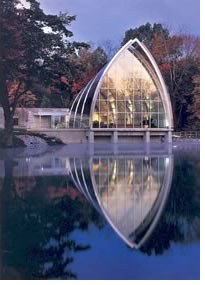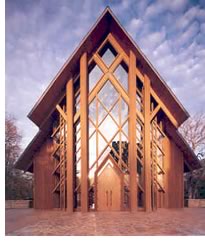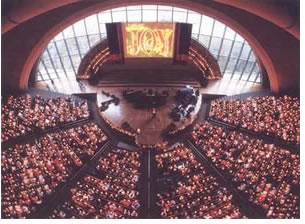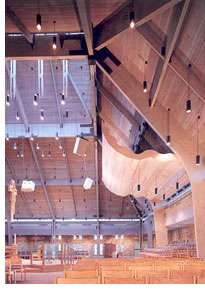

BOOK REVIEW
Architecture for the Gods, Book
II, by Michael J. Crosbie, PhD
(2003, Images Publishing)

 reviewed
by Stephanie Stubbs, Assoc. AIA
reviewed
by Stephanie Stubbs, Assoc. AIA
Managing Editor
Architecture for the Gods, Book II, pays homage to sacred built form and offers a visual banquet for architects through presentation of more than 50 contemporary projects representing all faiths. Its author, Michael J. Crosbie, PhD, AIA, editor of Faith and Form magazine and adjunct professor of architecture at Roger Williams University, has chosen, sequenced, and described the state of religious architecture in the U.S. today. His reasoned presentation is further enhanced by the exciting visual presentation that is the hallmark of Images Publishing.
Crosbie posits that the very best of sacred architecture goes beyond helping us “keep the faith” to challenging us to define more clearly what faith actually is. You can’t get there simply by repeating traditional forms, he says. The author admits a predilection toward religious projects that “take risks.” He has included, for example, a number of projects that blend spiritual practices with environmentalism, perhaps a new kind of theology or a return to one of the most ancient.
 Searching
for expression
Searching
for expression
Henry Luce Foundation President and former Yale University Professor John
Wesley Cook, who wrote the book’s introduction, perhaps best describes
the underlying structure of Architecture
for the Gods. Cook finds little commonality among the projects
presented. That’s a good thing, he says. It’s a signal that
religious architecture is undergoing a search for forms that appropriately
solidify worship today. “This collection, when studied carefully,
will illustrate that we have moved beyond easy solutions to the imaginative
state of being ‘in the search’ for adequate buildings to house
our best contemporary values for worship and the ongoing life of the spirit,”
Cook writes.
Although the forms range widely, in examining this collection of buildings, Cook has identified three major influences shaping religious architecture today.
- Nostalgia, which he deplores, “is unfortunately shaping our future.”
- Megachurches, which accommodate a large number of people via theater seating in “large amphitheater-shaped sanctuaries.” Technology, such as large-screen image projection, is very important to this kind of space, Cook notes.
- Creative use of new materials and technologies themselves, for instance glass for increasing natural illumination that doubles as a structural material, is shaping today’s religious buildings.
 Disparate
projects
Disparate
projects
Fifty projects back up these theories in a presentation format that architects
will love. The text is minimal—four or five paragraphs per project—and
serves as support for generous spreads of clear, large-format photos and
line drawings that let the projects speak for themselves. For instance,
the cover project, the Chapel of the Apostles, University of the South,
Sewanee, Tenn., shows architect Maurice Jennings + Daniel McKee Architects’
skill at uniting nature with buildings. (Jennings is the former partner
of Gold Medalist E. Fay Jones, FAIA, whose Honor Award-winning Thorncrown
Chapel clearly is a forerunner to the chapel.) The 8,500-square-foot building
does double duty as a classroom in which theology students study Episcopalian
ritual. Humble and uplifting materials—from the wood frame to the
flagstone forecourt and narthex—enhance the structure’s connection
to the site.
 Crosbie
has chosen the Riverbend Church, Austin, by Overland Partners, as a representative
of the megachurch genre. The sanctuary offers full television and broadcast
capabilities on the high-tech end, while a tremendous arched window wall
offers high-touch views of a ravine in the landscape beyond the building.
The amphitheater-styled sanctuary allows everyone to sit within 90 feet
of the altar. “The spectacular natural setting is the genesis for
an earthy palette of warm materials, including wood, limestone, sandstone,
and painted metal, used throughout the sanctuary,” Crosbie tells
us. At the entry, massive limestone monoliths anchor two masonry and glass
towers that act as beacons within the landscape.”
Crosbie
has chosen the Riverbend Church, Austin, by Overland Partners, as a representative
of the megachurch genre. The sanctuary offers full television and broadcast
capabilities on the high-tech end, while a tremendous arched window wall
offers high-touch views of a ravine in the landscape beyond the building.
The amphitheater-styled sanctuary allows everyone to sit within 90 feet
of the altar. “The spectacular natural setting is the genesis for
an earthy palette of warm materials, including wood, limestone, sandstone,
and painted metal, used throughout the sanctuary,” Crosbie tells
us. At the entry, massive limestone monoliths anchor two masonry and glass
towers that act as beacons within the landscape.”
 St.
John Vianney Catholic Church, Shelby Township, Mich., by Constantine George
Pappas, AIA, offers an example of how structural and materials innovation
literally is shaping the appearance of religious buildings. The 16,000-square-foot
church is considered to be the largest glue-laminated wood, compression-ring
structure in the world. A 2,400-square-foot clerestory soars to a height
of 80 feet above the church’s central altar.” The exterior
walls of the church are constructed of masonry, designed to provide lateral
stability while affording a feeling of grandeur,” Crosbie writes.
The glazing is set deep in the wall, allowing broad shadows to reinforce
the punched openings in the thick walls, reminiscent of the heavy masonry
walls of the earliest Christian churches.”
St.
John Vianney Catholic Church, Shelby Township, Mich., by Constantine George
Pappas, AIA, offers an example of how structural and materials innovation
literally is shaping the appearance of religious buildings. The 16,000-square-foot
church is considered to be the largest glue-laminated wood, compression-ring
structure in the world. A 2,400-square-foot clerestory soars to a height
of 80 feet above the church’s central altar.” The exterior
walls of the church are constructed of masonry, designed to provide lateral
stability while affording a feeling of grandeur,” Crosbie writes.
The glazing is set deep in the wall, allowing broad shadows to reinforce
the punched openings in the thick walls, reminiscent of the heavy masonry
walls of the earliest Christian churches.”
In some ways, Book II delves deeper than its well-received predecessor. Whereas Book I encompassed “the easy ones”—the more obvious choices for representational American religious structures—Book II offers more subtle choices. Taken as a whole, these projects reflect the latest efforts to find structurally eloquent ways to express our spiritual best, a quest as old as humankind itself.
Copyright 2003 The American Institute of Architects.
All rights reserved. Home Page ![]()
![]()
 |
||
| Purchase Architecture for the Gods, Book II from the AIA Bookstore, $53.96 members/$59.95 retail. To order: phone 800-242-3837, option #4; fax 202-626-7519; or send an e-mail.
|
||